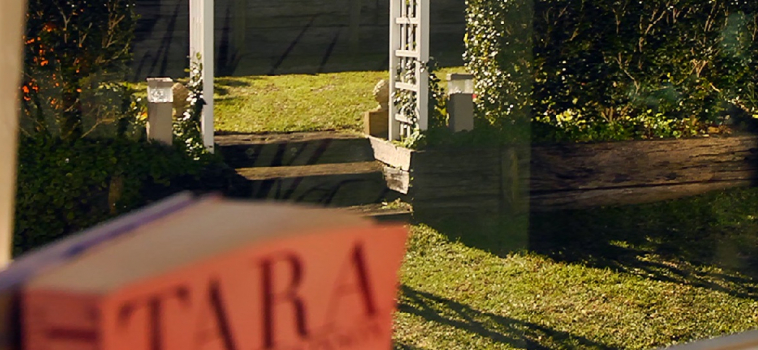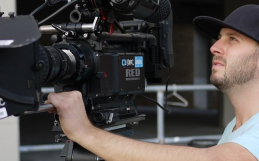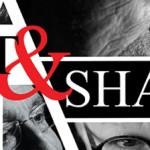As the Rolling Stones famously said “You can’t always get what you want” but thankfully with power of movie magic know one has to know.
Often when shooting you will find you want a shot that is not easily doable or not possible to do with what you have around in your location or not available to you in your kit. Its situations like these where you get tested for your ability to think outside of the box as well as you knowledge of cinema language.
What I mean by Cinema language is the knowledge of what your audience will believe, how much you have to do to make something convincing and how one shot relates to the next. This requires an understanding of the relationship images have with sound, the effect lights have on the environment, the relative relationship two or more thing have in your shot and the relationship one shot has with the next.
Oh no we don’t have a TV!
My friend, Director Shannyn Warren, was in the midst of shooting her short film on location at a nice big old Victorian era house. She had booked the location for the day only and as always the production was slightly behind scheduled. As the shots got knocked off we came to a simple shot of the main character walking in on his brother watching a movie. This was to be a very easy shot. But we soon realized we didn’t have a TV set.
We looked around the house and there was no TV in the house. Simple things like this can trip up small productions, as you don’t always have time to dot all the I’s and cross all of the T’s in the pre-production stage so some things do get missed.
So we don’t have a TV, there is no TV in the house and we have run out of time so we can’t go for a drive to get one. What to do? Well one of the things that I keep coming back to is if there is a problem in your shot, move the camera. If something doesn’t look right, don’t show it. So we didn’t have a TV, well do we need to see the TV? Not really. What if we show the effect the TV has on the actors instead? They are a lot more interesting anyway.
My quick and dirty solution was to sit our actors in the middle of the room as if they were watching a TV in the corner. I place a 2×4 flag on a C stand and blocked the camera. To one side of the flag I put a Lowel Pro Light on a clamp on the lower leg of the C stand to keep it at about the right height and put a full CTB on it. The Pro Light was connected to a dimmer that my assistant manually flickered to give the sense of TV light hitting our actor and as the camera moved along the slider out from behind the flag, you get the impression that he is watching a TV.
Now that you know how we did it you might think it looks a bit fake, and it does, but with a wee bit of the right music or sound effects the effect is sold to the audience. And this is the key, if your story telling skills, script and characters are good enough then your audience will not be looking for holes, they will believe the world you create. With just a little bit of movie magic your audience will take you up on your offer, suspend their disbelief and go along for the ride.
When Shannyn Warren’s film was screened to a great critical response no one even thought to question the possibility that the TV shot was faked.
Take a look at the result:
We slightly adjusted the angle of the flag and changed up the flickering to try to make it a bit more random for the take used in the film.
I imagined this shot to go up into the trees!
Some times the location is exactly what the Director wants but it’s the lack of time, small budget or the limit of the equipment is what gets in the way. This should not be a limit to your imagination though. For this next shot the Director wanted the camera to start low and head on up into the trees. Sounds great, lets hire a decent sized jib.
What, we don’t have the budget? We can’t get permission to set up bigger equipment in the location because it’s a public area? The location is remote and we can’t lug heavy kit out there easily? We don’t have time to deal with complicated kit and get it set up? All of these reasons and more might be why you can’t have exactly what you want to get the shot you are after. So what do you do?
It doesn’t take much convince the audience that the camera is moving. I remember reading about people congratulating Robert Rodriguez on the jib shot in his no budget film El Mariachi. He was surprised as there were no jib shots in his film, only a hand-held shot on top of a ladder. What this shows is that the audience can be convinced that more is going on than there really is simply because they only see what’s put on-screen. So lets put the trees on-screen.
Bring the Trees to us
The shot was achieved with very modest kit. Because we were shooting in the Centennial parklands in Sydney we were only allowed to have very minimal gear. We set the shot up on the edge of the bike path. The camera was to rise up from the ground as the actor rode past on a bike. The camera was to rise up into the trees, hold for a bit, and then roll credits. Problem was the trees were very high and we had no budget for a bigger jib and we would not have been allowed to shoot if we had tried to use more obtrusive gear than what we had.
The kit was a Miller Solo tripod with a pocket jib made by Light Craft Workshop at full extension. The trees were too high for us to reach with the jib so we simply picked up a branch from the garden area and held it up at the top of the jibs’ movement so it would creep into the edge of frame just to sell the effect that we were up at tree level.
For a very simple effect it can really add just that wee bit extra to make the shot more interesting and it takes very little to be convincing.
Take a look at the first take:
We stopped down and added ND to push the branch a bit more out of focus for the final take and got the move a bit smoother.
INT. KITCHEN. DAY.
JENNY watches through the window as he clambers over the fence in a drunken state.
Director Matt Graham wanted to shot a short comedy about a guy coming home after a crazy night out. Sounds like fun I said. What are our locations like? We had a look and most of them looked good. The only one that stood out as being difficult was Matt’s’ friends’ place where the back yard scene was to be shot. The only window was a very thin window high up that no one could easily look through. I really wanted to tie the shot of Jonno coming over the fence with Jenny watching from the inside.
We could have just shot the yard and then cut to Jenny looking through the window from a different location but I thought we could do it a bit better. One thing I like to do is if possible try to include some foreground into every shot, it’s often forgotten but adds depth. It can be over done obviously and I have been guilty of that on occasions as well.
We need a Window
We needed to create a window to look through so we called recycle garbage and tried to get an old window to use. Unfortunately they didn’t have any. What they did have was an old door with a large glass panel. It would do just fine.
We mounted the door on its side using two C stands. We had already nailed a shelf onto the bottom to hold the objects at the bottom of frame. Then we decorated the shelf with books, a flower and some cloth for curtains. At this point it looked OK, but the sun was streaming over the top making it look a bit weird. To solve this I set up a flag on camera left, just out of frame, to shade the inside of the windowsill so it looked as if it was actually inside a house.
All in all I think it looked quite good and once in the edit it was very convincing. What do you think:
The final shot was adjusted to remove the reflection coming from behind the camera and the movement of the camera was reduced a bit. If we had more time I would have made sure it was completely parallel with the wooden garden beds.
It’s all smoke and Mirrors!
For some locations the whole set can be cheated. Walls can be flown out of the way for the camera or lights to come in; the Roof can be removed so as to light the actors effectively. All of these are wee lies that the audience doesn’t know about or want to know about. If your audience is wondering about such things then you have lost them already as they are not engaged in the story and the characters.
The job of the Director of Photography is to help the Director to tell the story effectively. It’s all well and good to make pretty images but if they are distracting from the story or they are not convincing then they are not helping the production. Some times the challenges we face are making the most of what we have and it is easy to want more gear, more people or more time, but with some imagination you can over come these challenges. You can also use these skills to help tell the story, by making shots more convincing or by connecting one shot to another by sharing an element in the frame.
So..
What are some of the trick you have used to help sell a shot or tie parts of the story together?
If you have any tips or trick, let us know we can add it to the post.






